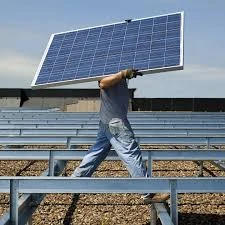Advancements in Bifacial Solar PV Technology for Enhanced Energy Efficiency and Sustainability
The Promise of Bifacial Solar PV Technology
In the quest for sustainable energy solutions, bifacial solar photovoltaic (PV) technology has emerged as a promising option, capturing the attention of researchers, engineers, and energy investors alike. Bifacial solar panels, as their name suggests, can absorb sunlight from both sides, maximizing energy generation by utilizing the albedo effect—reflective sunlight from the ground or surrounding surfaces.
Understanding Bifacial Technology
Traditional solar panels typically consist of a single layer of photovoltaic cells mounted on a flat, opaque backsheet. In contrast, bifacial panels have solar cells on both the front and back sides, allowing them to capture sunlight in two directions. This design enhances energy efficiency and productivity, particularly in setups with reflective substrates, such as white roofs, sandy terrains, or snow-covered areas.
The bifacial technology utilizes not just direct sunlight but also diffused light reflected from surfaces beneath the solar array, which leads to increased energy yield. This gain can be substantial; reports suggest that bifacial panels can produce anywhere from 10% to 30% more electricity compared to traditional monofacial setups, depending on various environmental conditions.
Benefits of Bifacial Solar PV
The advantages of bifacial solar PV extend beyond mere energy production. Firstly, the reduced land footprint is a significant factor in areas where space is at a premium. By leveraging both sides of the panels, developers can achieve higher energy outputs in the same geographic area. This is particularly beneficial in utility-scale solar farms and urban environments where land is limited and costly.
Additionally, bifacial panels exhibit improved durability and performance reliability over traditional panels due to their reduced shading issues. They tend to have a longer lifespan, are less susceptible to PID (Potential Induced Degradation), and can perform better in high-temperature scenarios, making them increasingly attractive for long-term investment perspectives.
bifacial solar pv

Installation Considerations
While bifacial solar PV technology holds great promise, its installation does require strategic considerations. The arrangement of the panels is crucial; for maximum performance, bifacial modules should be installed at an optimal height and angle to facilitate sunlight absorption from multiple directions. The strategy often includes elevated mounting systems and the use of reflective ground materials to enhance energy collection.
Moreover, accurate prediction of the energy yield can be more complex due to the varying albedo effects based on geographical location, climate conditions, and surface materials. Investors must engage in careful modeling and simulations to gauge the potential efficiency gains from bifacial systems accurately.
Future Prospects
As the global demand for renewable energy continues to rise, bifacial solar PV technology represents a significant and innovative advancement in solar energy. With ongoing research and development efforts, manufacturers are increasingly producing more efficient and cost-effective bifacial modules, which could lead to wider adoption and integration into various energy systems.
The long-term sustainability goals outlined in various international agreements also provide a favorable backdrop for the expansion of bifacial solar PV technology. As both policymakers and consumers seek to transition away from fossil fuels and towards greener energy solutions, the role of advanced technologies like bifacial solar panels will undoubtedly be critical in achieving these targets.
In conclusion, bifacial solar PV technology stands at the forefront of solar innovation, offering numerous benefits over traditional systems. With its capacity to harness energy more efficiently and reduce the cost per watt of solar energy produced, it could play a pivotal role in shaping the future of renewable energy. As awareness and investment in this technology grow, its integration into energy strategies worldwide could lead to more sustainable energy solutions for generations to come.
-
String Solar Inverter: The High-Efficiency Solution for Smart Solar EnergyNewsJul.14,2025
-
Revolutionizing Rooftop Energy with the Power of the Micro Solar InverterNewsJul.14,2025
-
Power Independence with Smart Off Grid Solar Inverter SolutionsNewsJul.14,2025
-
On Grid Solar Inverter: Powering the Future with Smart Grid IntegrationNewsJul.14,2025
-
Monocrystalline Solar Panels: High-Efficiency Power for the Future of Clean EnergyNewsJul.14,2025
-
Bifacial Solar Panel: A Smarter Investment for Next-Generation Energy SystemsNewsJul.14,2025







